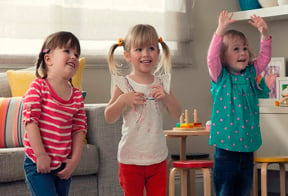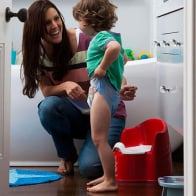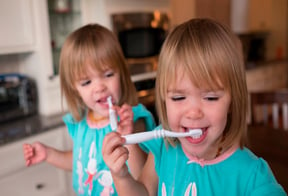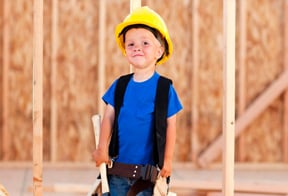Every family experiences potty training highs and lows, but it can be especially challenging for parents that work outside the home and families that enroll their children in daycare or preschool.

Be on the Same Page with Childcare Provider
If your childcare provider initiates the training, or if your child shows interest when in their care, listen to their suggestions and approach. Be sure to discuss the potty training process and technique with your childcare provider to ensure you are on the same page, that way there won’t be any surprises.
“Be open with and listen to your provider, as he or she has likely taught many children to use the toilet. Their expertise may guide you. After all, if this is your first child, potty training may be one extra stress you’re not eager to take on. A person such as your child’s caregiver can offer you support as you guide your child to use the toilet at home,” advises Faull.
Communication is Key with Childcare Providers
“Talking about a child is a form of attention and reinforces their behavior. Therefore, talk up potty training triumphs, but when it comes to challenges or stumbling blocks, discuss these over the phone when the child is not in ear shot,” says Faull.
And “If your child is using the potty with the caregiver and not at home, remember that it isn’t a competition. Don’t feel like you are doing something wrong. Stick to the plan and the child will get it at home soon, too,” advises Pull-Ups® Potty Training consultant Dr. Laura Bennett-Murphy, Ph.D.
Constant communication with your childcare provider is essential for a successful training program. Ask questions daily, such as: What’s working? What’s not working? How did training go each day? By working closely with your child’s care providers and being consistent with a potty training routine, your child will be on his way to being a potty pro, both at home and at daycare.
Be Considerate of Potty Training Helpers
If your child has lots of accidents in the childcare setting, be sure to provide extra Pull-Ups® Training Pants. Or when your child goes from training pants to underwear, it’s a good idea to pack extra underpants and clothes as well just in case; it will really be appreciated.
Be Consistent at Home and at Daycare
Another proof point can be found with a father, Marcus Hopper, when he was worried that the potty training progress his daughter made at home would be set back on the three days a week she attends daycare. Initially, this was the case. “She really didn’t start making consistent progress until the provider agreed to work with us in following the same steps we take at home at daycare,” says Hopper, of Pleasant Hill, CA. The process was initiated when the provider asked what was working well at home.
Remember that Each Child is Different
“Because all children are different, so are their routines for learning new tasks,” she says. “You have to experiment to find what will work for your child. Also, remember to discuss new findings with your childcare provider and ask them what works for your child at school. Together, you can help your child succeed.”











